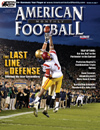AMERICAN FOOTBALL MONTHLY THE #1 RESOURCE FOR FOOTBALL COACHES
|
|
Article Categories
|
Speed Report – Intense Frequency, Execution and Focus - Essentials for Football Speedby: Dale BaskettFootball Speed Specialist© More from this issueWhen training for football speed, it’s critical that we have sound application principles, strong precise technical execution and strong mental focus. I have implied numerous times in past articles that running fast requires practical foundational applications.
Frequency of limb speed is probably one of the most important facets of movement necessary for a football player. Subsequently, limb speed is often termed quickness. Developing limb frequency requires the following steps. One, constant mechanical execution and a highly intensified focus.
High Intensity -
Tapping the Nervous System
One must run fast to be fast and muscle contraction must be quick to become quick. To tap the nervous system properly, you need to activate muscle contraction to its highest elevation. The g....The full article can only be seen by subscribers.
Subscribe today!

|
|
|
NOT A SUBSCRIBER?
Subscribe
now to start receiving our monthly magazine PLUS get INSTANT
unlimited access to over 4000 pages of 100 percent football coaching
information, ONLY available at AmericanFootballMonthly.com!
|
|
|
HOME
|
MAGAZINE
|
SUBSCRIBE
|
ONLINE COLUMNISTS
|
COACHING VIDEOS
|
Copyright 2025, AmericanFootballMonthly.com
All Rights Reserved






